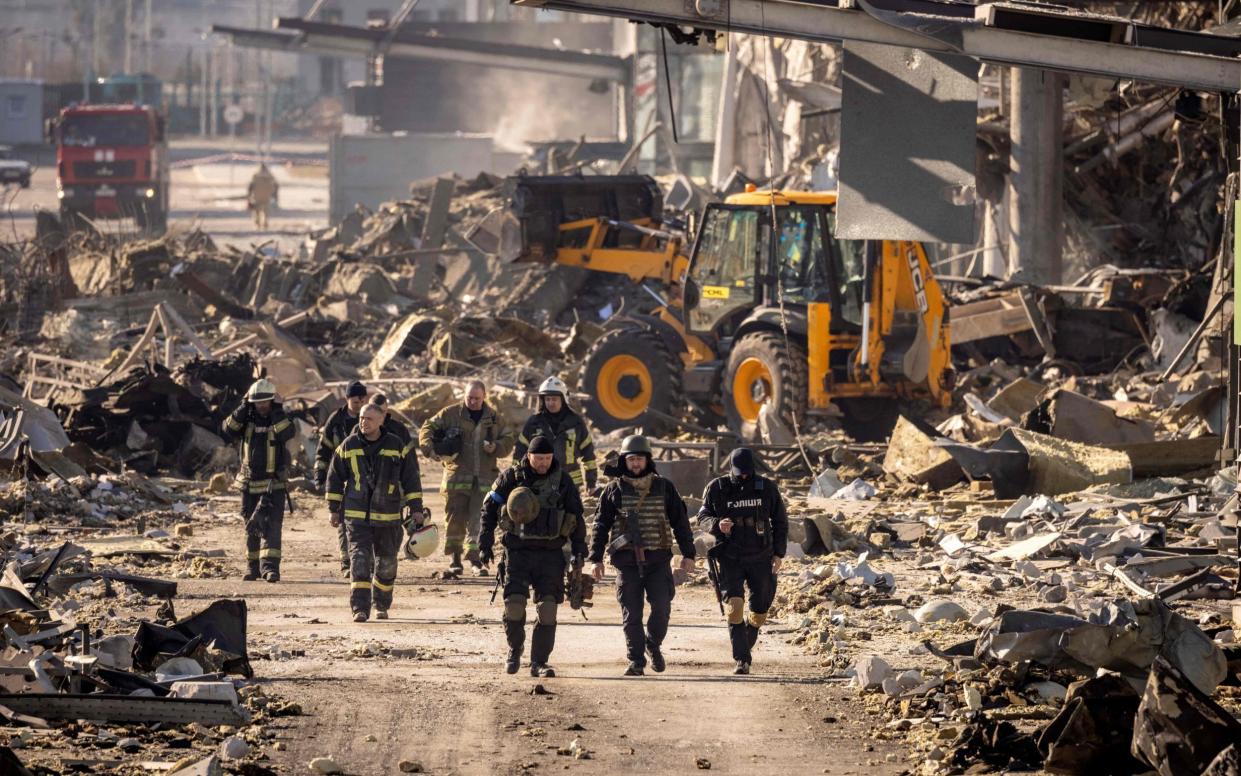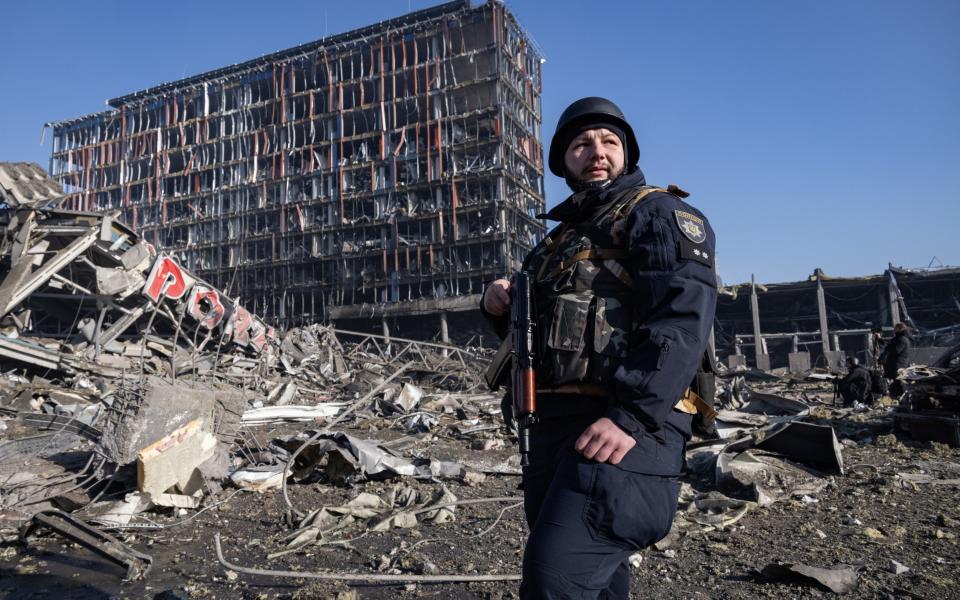‘Like swimming against the current in sulphuric acid’: The battle to supply Ukraine with food

Like his counterparts at Waitrose and Sainsbury’s, Ukrainian supermarket boss Dmytro Tsygankov is keen to source produce from neighbourhood suppliers. Few “buy local” schemes, though, have been quite like the one his chain launched after the start of the Russian invasion last year.
“We lost a lot of suppliers during the war, and two of our distribution centres were destroyed, so we struck up agreements with lots of little local producers – everything from grains and cereals to confectionary and cookies,” he says.
True, in the hurry, not all the new grocery offerings were guaranteed organic, nor were gluten-free and vegan options always available. The priority, Tsygankov says, was “just to get food on the shelves.” But it helps explain why of all the privations that Ukraine has suffered during the past 15 months of war, its supermarket shelves have generally remained remarkably well-stocked.
Indeed, it's here in Britain where a scarcity of food has been a story: this month, roast chicken joined the long list of staples in short supply that already includes eggs and fresh veg. The shortages have been blamed variously on everything from Brexit and inflation through to lousy growing weather. As excuses go, though, these hardly compare with being invaded by the world's second superpower. So how on earth has Ukraine done it?
I first asked myself that question during the very first week of the invasion, while heading to Kyiv to report for The Telegraph. While truth is often said to be the first casualty of war, the second is usually the local supermarket shelves, which empty rapidly as panic buying ensues. A colleague who had just left Kyiv had already suggested packing – along with the flak jacket and helmet – a bag full of emergency rations.
“Take as much as you can,” he urged. “No food in the hotels, and there'll be panic buying in all the shops – if they're open.”
The advice seemed sensible. Not only were roads and bridges being bombed, forces loyal to Russian's shoplifter-in-chief, Vladimir Putin, were looting every store they came across in the cities they were seizing.
So it was more out of curiosity than hunger, which led me to wander into the first supermarket I found open, as air-raid sirens wailed across Kyiv. Far from being bare, it was stocked with everything you'd find at a north London Waitrose, from a choice of Parma hams and granolas through to edamame, fresh carp and a decent wine aisle (sadly roped off because of a wartime booze ban). The only thing unavailable was fresh bread, and even that re-appeared soon after.
That I dined on caviar and French cheese on that first night in Kyiv rather than dried emergency noodles was thanks to people like Tsygankov, a director at Ukraine's nationwide Silpo supermarket chain. He realised that keeping the country well-fed would be as crucial to its survival as keeping it well-armed. When Russian tanks first laid siege to Kyiv, the 44-year-old was at his family home in Irpin, a suburb that was right in the frontline of the Russian assault.

“First, you could hear artillery flying overhead and military aircraft, and then the sound of small arms fire, which was even scarier as it showed the battle was getting closer,” he told me by Zoom this week. “We couldn't get out of Irpin anyway at that time, so my wife and I went to my firm's local store and took control of the warehouse, with her on the cash desk – we just sold everything we could. Being busy actually helped to keep us calm.”
The real challenge, though, has been in keeping the shelves filled up again. Over the last year, Russian bombs have hit everything from bottle makers and grain silos through to factories making biscuits and crisps. Tsygankov's chain alone lost £65m worth of assets to looting and destruction. During the war's first few first months, roughly one in 10 of its 750 stores was shut because of fighting or Russian occupation.
With Russia's navy blockading Odesa, Ukraine's main Black Sea port, a key conduit for foodstuffs remains closed, save for a UN-brokered agreement to allow grain exports. Thousands of supermarket staff also left the country as refugees, while others have volunteered for the front. Given how Covid lockdown exposed the fragility of modern food supply chains, it would be easy to imagine Ukraine's supermarket shutting altogether.
A key first step was switching supply routes – firstly from Black Sea ports to routes overland from Europe, and then from lorry to train. (Ukraine's railways have been left largely intact during Putin's onslaught, because his own forces rely on railway resupply). Supermarkets also became makeshift food aid hubs, using volunteers to help out at unloading depots. When Putin's missiles began targeting Ukraine's power infrastructure last autumn, Tsygankov rolled out a program to equip every store with its own generator and Starlink satellite internet hub. Throughout the war, his firm has also kept a cheery running commentary on its Facebook page.
“Dear friends, together we have lived 16 hours of war,” reads one post on the invasion's first day. “Baguettes are ripening in the bakeries – we’ve reduced the assortment so that we can bake even more. We’ve started packing cereals that will arrive in stores tomorrow, so you can replenish your supplies.”
Acting as humanitarian hubs has not spared the supermarkets from being targeted directly. In Kyiv, the Retroville shopping mall – a giant venture on a scale with Manchester's Arndale – was reduced to an enormous Ground Zero of smoking ruins during the third week of the invasion by a cruise missile. A mall in suffered the same fate last May, just days after I'd had lunch there. The following month in the central city of Kremenchuk, a missile attack on a mall killed at least 18 people and injured 60 others, including six of Tsygankov's employees.

“I can think of only two explanations, the Kremlin targets supermarkets. One is that they’re completely nuts – the other is they are f--king idiots who are missing their intended targets,” he says. “After all, why send a ten million dollar missile into a supermarket?”
The Kremlin claims that Ukrainian malls have been used as military depots: after the Retroville mall attack, Russia's defence ministry released video evidence of rocket launchers parked under an awning there. But whatever the truth of the matter, the targeting of the malls sparked widespread outrage – not least because they offer a taste of a European consumer good life that had long been absent from post-Soviet Ukraine.

Retroville, for example, which had only opened in 2020, had not just supermarkets but a cinema, Tuscan wine bar and hipster gastropub selling craft beers. It also hosted an arts and music festival, Halloween nights and dinner dances. Silpo's supermarkets, meanwhile, are like a cross between Waitrose and a pleasure-park, with stores decked out in different themes. Silpo's River Mall in Kyiv, for example, is styled like a yacht club, while the branch in Kharkiv has a Star Trek theme, complete with signs in Klingon. At open-plan kitchens, customers can have their food purchases cooked by an in-house chef, paired with a bottle of shop-bought wine without corkage charges.
The missile-wrecked supermarkets, though, have shown the same resilience that has seen Ukraine patch-up bombed power lines, fuel depots and bridges. Within six months of the Retroville Mall being missiled, three-quarters of it was back up and running. “Our task as a business is to help the country’s economy, return jobs and pay taxes," said Renata Lakubcheniene, its director. “Customers really wanted us to reopen again, and volunteers helped us clean it up, so we re-opened earlier than planned.”
The national food supply logistics effort has been exhausting for all concerned – Tsygankov describes it as “swimming against the current in sulphuric acid”. But it means that as of today, even towns close to the frontlines will still have a well-stocked supermarket – the aisles often full of heavily-armed soldiers pushing trolleys.
By contrast, areas under Russian occupation have seen their local food economies collapse to Soviet-style levels. In the Black Sea port of Kherson, residents ended up relying on street markets that were little more than car-boot sales until the city was retaken by Ukrainian forces in November.
So are there any essentials that Ukrainians are still short of? In the early days, there were blips with long-life products and items like sanitary towels. Today, though, Tsygankov can only think of one – salt. Much of Ukraine's supplies used to come from salt mines in battle-ravaged Donbas town of Bakhmut, which Russia now seems to be on the verge of taking. But a plan is already in hand.
“Bakhmut used to provide about 95 per cent of the market, but we've found a different supplier in western Ukraine,” he said. “Shortages can nearly always be sorted out.”

 Yahoo News
Yahoo News 
